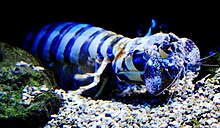
Back Stomatopoda Afrikaans فميات الأرجل Arabic فميات الارجل ARZ Stomatopoda Byelorussian Устоноги Bulgarian চিংড়িবাহার Bengali/Bangla Estomatòpodes Catalan Hà-kŭ CDO Stomatopoda CEB Søknælere Danish
| Mantis shrimp Temporal range:
| |
|---|---|

| |
| Odontodactylus scyllarus (Red Mantis Shrimp) | |

| |
| Lysiosquillina maculata (Zebra Mantis Shrimp) | |
| Scientific classification | |
| Domain: | Eukaryota |
| Kingdom: | Animalia |
| Phylum: | Arthropoda |
| Class: | Malacostraca |
| Subclass: | Hoplocarida |
| Order: | Stomatopoda Latreille, 1817 |
| Subdivisions[1] | |
|
Superfamilies and families Bathysquilloidea
Erythrosquilloidea Squilloidea Eurysquilloidea Parasquilloidea | |
Mantis shrimp are carnivorous marine crustaceans of the order Stomatopoda (from Ancient Greek στόμα (stóma) 'mouth' and ποδός (podós) 'foot'). Stomatopods branched off from other members of the class Malacostraca around 400 million years ago,[2] with more than 520 extant species of mantis shrimp known. All living species are in the suborder Unipeltata, which arose around 250 million years ago.[2][3] They are among the most important predators in many shallow, tropical and subtropical marine habitats. However, despite being common in their habitats, they are poorly understood, as many species spend most of their lives sheltering in burrows and holes.[4]
Dubbed "sea locusts" by ancient Assyrians, "prawn killers" in Australia,[5] and now sometimes referred to as "thumb splitters" due to their ability to inflict painful wounds if handled incautiously,[6] mantis shrimp possess powerful raptorial appendages that are used to attack and kill prey either by spearing, stunning, or dismembering; the shape of these appendages are often used to classify them into groups: extant mantis shrimp either have appendages which form heavily mineralized "clubs" that can strike with great power, or they have sharp, grasping forelimbs used to swiftly seize prey (similar to those of praying mantis, hence their common name).
- ^ Joel W. Martin & George E. Davis (2001). An Updated Classification of the Recent Crustacea (PDF). Natural History Museum of Los Angeles County. p. 132. Archived from the original (PDF) on 2013-05-12. Retrieved 2009-12-14.
- ^ a b Van Der Wal, Cara; Ahyong, Shane T.; Ho, Simon Y. W.; Lo, Nathan (21 September 2017). "The evolutionary history of Stomatopoda (Crustacea: Malacostraca) inferred from molecular data". PeerJ. 5: e3844. doi:10.7717/peerj.3844. PMC 5610894. PMID 28948111.
- ^ "Stomatopoda". Tree of Life Web Project. January 1, 2002. Archived from the original on October 2, 2022. Retrieved August 26, 2007.
- ^ Ross Piper (2007). Extraordinary Animals: An Encyclopedia of Curious and Unusual Animals. Greenwood Press. ISBN 978-0-313-33922-6.
- ^ "Mantis shrimp". Queensland Museum. Archived from the original on January 21, 2021.
- ^ Gilbert L. Voss (2002). "Order Stomatopoda: Mantis shrimp or thumb splitters". Seashore Life of Florida and the Caribbean. Dover pictorial archive series. Courier Dover Publications. pp. 120–122. ISBN 978-0-486-42068-4.